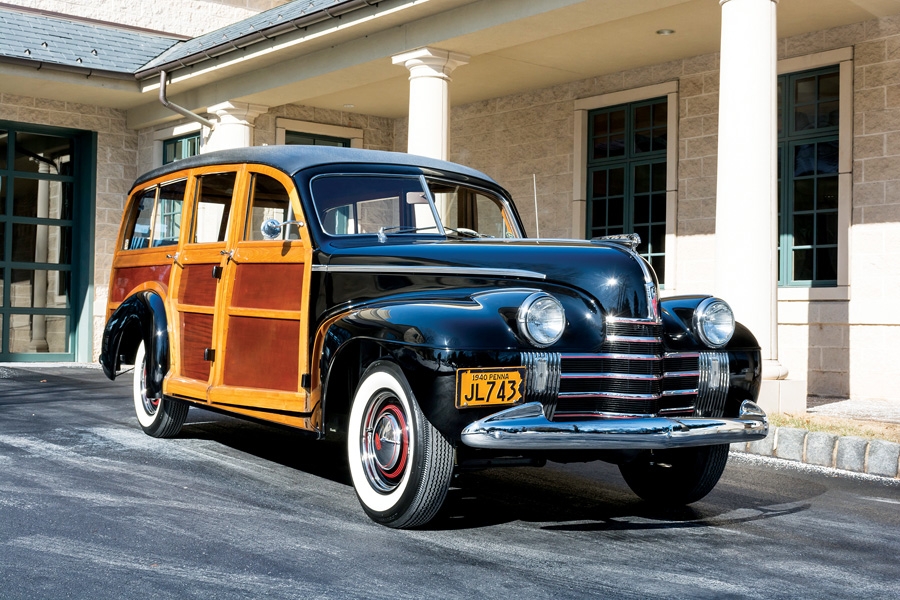SCM Analysis
Detailing
| Vehicle: | 1940 Oldsmobile Dynamic Series 70 woodie wagon |
| Years Produced: | 1940 |
| Number Produced: | One |
| Original List Price: | N/A |
| SCM Valuation: | $35,000–$45,000 |
| Tune Up Cost: | $250 |
| Distributor Caps: | $45 |
| Chassis Number Location: | Left side frame rail under hood |
| Engine Number Location: | Upper left corner of block |
| Club Info: | National Woodie Club |
| Website: | http://www.nationalwoodieclub.com |
| Alternatives: | 1941 Oldsmobile woodie wagon, 1940 Packard One-Ten wagon, 1941 Chrysler Town |
| Investment Grade: | D |
This car, Lot 125, sold for $46,200, including 10% buyer’s premium, at Bonhams’ Amelia Island, FL, auction at the Fernandina Beach Golf Club on March 12, 2015.
The glistening wood-bodied station wagons, finished in fine mahogany and white oak, began life as far more plebeian and utilitarian vehicles.
Shortly after the turn of the 20th century, furniture makers made inexpensive wood bodies for automobiles or small trucks. These cars and trucks were “depot hacks.” Travelers by rail or ship used large steamer trunks that could not fit into standard cars or taxis, so the upscale resorts used depot hacks to transport their guests and their extensive, bulky luggage.
In the late 1920s, custom body firms such as Martin-Perry and Cantrell did sizeable business selling wood “depot hack” bodies for the Ford Model T. Edsel Ford envisioned a line of more-refined station wagons for the Model A line.
Edsel also had another motive, as he had just completed his 21-room estate in Seal Harbor, ME, and an elegant wood-paneled station wagon would be just the thing for the caretaker to meet the Ford entourage when they arrived in their personal rail car.
Rarely profitable and often rickety
Ford was not the first to offer a production depot hack or wood station wagon, as the short-lived 1923 Star Station Wagon has that distinction. Throughout the 1930s, almost all of the major car makers offered their own wood-bodied station wagons with varying degrees of success.
As these woodies were handmade, they were very labor intensive and rarely profitable. They squeaked, often leaked, and required constant care and refinishing. Even with proper maintenance, they were prone to moisture damage, rot and discoloration.
After World War II, as car makers caught up with the pent-up demand, they turned to new, more modern designs, which spelled the end of the woodie. The last major manufacturer to offer a production wagon with an actual wood exterior was Buick in 1953.
Oldsmobile’s woodies
Chevrolet, the largest car maker of the time, waited until 1939 before offering a woodie, and Oldsmobile followed two years later.
Oldsmobile only offered the woodie on their entry-level Special 60-Series, which shared the same 116-inch wheelbase and dimensions as the Chevrolet Special Deluxe Wagon. The Mid-State Body Company in Waterloo, NY, a long-term supplier of custom commercial bodies to General Motors, was contracted to make the woodies. The number produced in 1941 is not known, but it is thought that only five or six remain — and at least one is a poor representation of a hot rod.
Not a factory prototype or special
We face a quandary with the 1940 Oldsmobile Dynamic Series 70 Woodie Station Wagon offered by Bonhams. Oldsmobile never admitted to making such a vehicle. A station wagon is not listed in any 1940 Oldsmobile marketing materials, and they are only listed in 1941 as being offered on the shorter Special Series.
This wagon was discovered in a barn in Pennsylvania in 1988, where it had been tucked away for 30 years. A 20-year restoration followed, with as much of the original wood and interior leatherette as possible retained.
With no documentation, we can look at three possible scenarios:
This car could have been a design study for a possible future Oldsmobile offering.
It was made as a special car for an Oldsmobile executive, as the company planned to offer woodie station wagons the following year.
Finally, it was a custom made by someone after the fact as a one-off example of his craftsmanship.
Since no information has surfaced in the ensuing years regarding a special 1940 woodie project at Oldsmobile, we have to assume that someone mounted a 1941 Series 60 wood body on a 120-inch-wheelbase 1940 Dynamic for personal enjoyment.
The value for a documented factory special or prototype is far different than for a non-factory custom rebody. Had this been a factory project, then Bonhams’ estimate of $75,000–$100,000 would be realistic. Since we are lacking evidence to the contrary, we have to assume the worst-case scenario — the car is a one-off custom — and look at the price paid as even being a bit aggressive. ♦
(Introductory description courtesy of Bonhams.)
